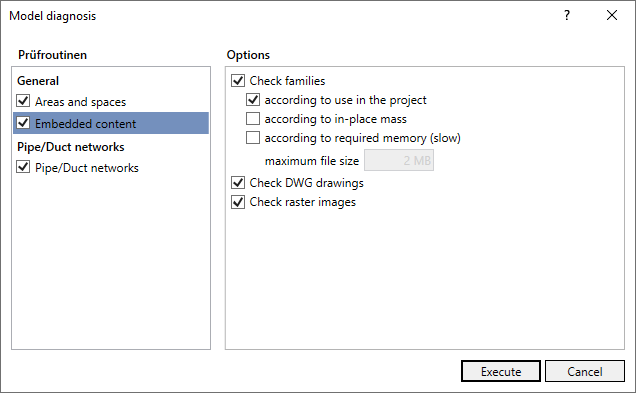Details on Test Routines of the Model Diagnostics
Information about the test routines in the Model Diagnostics dialog and the corresponding Options.
You are here:

Embedded contents
If you select the Embedded Contents test routine, you can set the following options for testing:
| Options | Description |
|---|---|
| Check family | The families used in the model are reviewed. |
| according to use in the project | The model is checked for families not being used. |
| according to in-place mass | The model is checked for the use of in-place mass. These can be replaced with families if necessary to clean up the model. |
| according to required memory (slow) | The families are checked in the model based on the required memory. This option checks whether families may be too large. |
| maximum file size | If you select according to required memory (slow), you can set the maximum file size for used families in this field. |
| Check DWG drawing | The DWG drawings used are output. |
| Check raster images | The model is checked for unused raster images. |
Areas and spaces
If you select the Areas and spaces test routine, you can set the following options for testing:
| Options | Description |
|---|---|
| Check area and volume computations settings | The settings for the calculation of areas and volumes of the spaces are checked. |
| Check spaces | The spaces in the model are checked. |
| Observe spaces in links | The existing spaces are matched with those in the linked architectural model. |
| find unplaced spaces | The model is checked for spaces that are not placed but are still present in the model. |
| find not enclosed rooms | The model is checked for not enclosed rooms. This includes, for example, rooms that do not have boundary walls. |
| find redundant rooms | The model is checked for redundant rooms. This includes rooms that have been placed twice and are thus on the same area and border the same walls. |
| Check volume | The room volumes in the model are checked. Values for the minimum height and minimum area have to be specified for this test. |
| Check spaces | The spaces in the model are checked. |
| find unplaced spaces | The model is checked for spaces that are not placed but are still present in the model. |
| find not enclosed spaces | The model is checked for not enclosed spaces. This includes, for example, spaces that do not have boundary walls. |
| find redundant spaces | The model is checked for redundant spaces. This includes spaces that have been placed twice and are thus on the same area and border the same walls. |
| Check volume | The room contents or the room volumes of the spaces in the model are checked. Values for the minimum height and minimum area have to be specified for this test. |
| Check enveloping surfaces | Enabled: Checks and counts the enveloping surfaces of each space when performing the check routine. In the next field, enter the threshold from which a space should be reported as a problem. This check can be performed before building detection to optimize the performance of the detection. |
| Warning as of a number of | Threshold value above which a message is displayed in the Issues and Tasks tab after the running of the check routine if this option is activated. The message in the Issues and Tasks tab contains information on the optimization of the enveloping surfaces. |
| Check areas | The areas in the model are checked. |
| find unplaced areas | The model is checked for areas that are not placed but are still present in the model. |
| find not enclosed areas | The model is checked for not enclosed areas. This includes, for example, areas that do not have boundary walls. |
| find redundant areas | The model is checked for redundant areas. This includes areas that have been placed twice and thus border the same walls. |
Pipe/Duct networks
If you select the Pipe/Duct networks test routine, you can set the following options for testing:
| Options | Description |
|---|---|
| Check activated system calculations | The system calculations activated in Revit for the model are checked. When using Pipe and Air Duct Network Calculation the system calculations of Revit are not additionally needed and can therefore be deactivated. |
| Check pipes | The pipes and pipe connections in the model are checked. |
| Find collisions with connected components | The model is checked for collisions of pipes or ducts with connected components. |
| Find pipe connections without transition | The model is checked for pipelines connections without transitions. |
| according to geometry | The pipes are checked for missing geometry. |
| Check air ducts for double insulation (interior/exterior) | The air duct networks will be checked for double insulation, i.e., it will be checked if there is both interior and exterior insulation. |